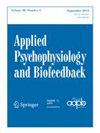sEMG Biofeedback for Episodic Migraines: A Pilot Randomized Clinical Trial
Abstract
The aim of this study was to assess the feasibility and potential effectiveness of a 6-week virtual sEMG biofeedback intervention for patients with episodic migraines. Patients with episodic migraines were randomized to treatment with a novel surface EMG (sEMG) at-home biofeedback device or a treatment as usual control group; they completed validated baseline and post-intervention assessments of migraine related disability (migraine-specific quality of life, anxiety and depression). Participants also underwent a series of Quantitative Sensory Testing (QST) procedures referring to several different tests that quantitatively assess responses to mechanical stimuli during two separate visits (baseline and post intervention). No adverse events were reported during the study. Compared to the treatment as usual comparison group, patients in the sEMG biofeedback group reported lower migraine disability (p < 0.05). Compared to baseline, participants in the sEMG biofeedback group demonstrated statistically significant reductions in anxiety (p < 0.01), and significant increases in quality of life (p < 0.001), and significant decreases in temporal summation (p < 0.05) assessed by QST. No significant changes were observed in any of the outcomes in the control comparison group (p > 0.05). No significant changes were observed in migraine frequency in either of the two groups (p > 0.05). In addition, mediation analyses revealed that changes in migraine related quality of life mediated group effects on changes in migraine disability. Virtual sEMG biofeedback shows promise as a potential therapy for reducing disability, anxiety and depression and improving quality of life in individuals with episodic migraines. These results demonstrate the feasibility of a digital intervention for migraines and set the basis for conducting a future, larger scale randomized controlled trial to confirm these preliminary findings.


 求助内容:
求助内容: 应助结果提醒方式:
应助结果提醒方式:


